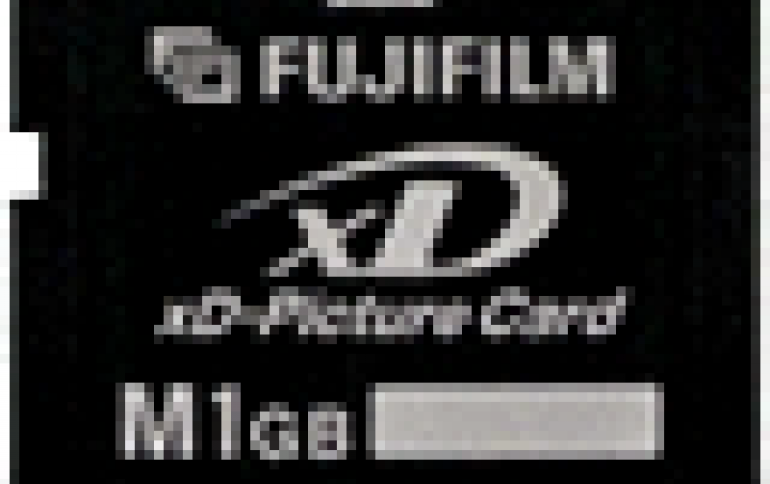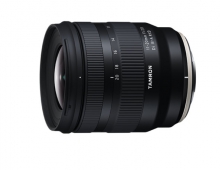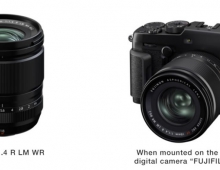
Fujifilm unveils 1GB xD-Picture card type M
Fuji Photo Film U.S.A. announced the April availability of the Fujifilm 1GB xD-Picture Card? Type M and will unveil the new card design at their booth at the Photographic Marketing Association (PMA) show in Orlando, Florida.
This new flash memory card utilizes Multi Level Cell (MLC) architecture, a new high-density flash memory technology. This advances the technology introduced in traditional xD-Picture Cards to provide a convenient aftermarket product for next generation cameras.
The 1GB xD-Picture Card? Type M architecture was chosen to take advantage of next generation camera characteristics, and are completely compatible with all 2005 models of Fujifilm digital cameras.
"Consumers are now very comfortable with digital photography and are demanding increased capacity while maintaining quality of the image," noted Bill Drysdale, Vice President, Digital Devices, Fuji Photo Film U.S.A, Inc. "Consumers want to take a lot of images, make high-quality prints to store and share - and they want it at a good price point."
At 1GB, the Fujifilm xD-Picture Card can approximately hold more than 1300, 600 and 400 images at 3, 6 and 12 megapixels, respectively. The technology highlights Fujifilm's focus on maximizing photographic storage with minimal space/cost for today's most advanced compact digital cameras.
Currently one of the smallest, lightest flash memory cards available, the xD-Picture Card format is comparable in size to a penny, measuring just 0.79" x 0.98" x 0.07" and weighing less than one-tenth of an ounce.
Fujifilm xD-Picture Cards are now available in storage capacities from 64 MB to 1GB, with capacity expected to reach 8GB on a single card in the near future.
Consumer-driven technology
Consumers are taking more digital images than ever. Because of the need for increased capacity in a small form factor, Fujifilm and Olympus scientists have integrated high density MLC (Multi Level Cell) memory technology into the new xD architecture to make it possible to pack 1GB into an ultra-compact card.
First launched in September 2002 in conjunction with Olympus, the xD-Picture Card technology has a capacity potential of 8GB. Fujifilm will continue to boost the performance of the xD-Picture Card? to meet the trend for increasingly high-resolution digital cameras and the diversification of shooting styles.
The new Fujifilm 1GB xD-Picture Card Type M is compatible with most USB card reader/writers, allowing digital images on the card to be read directly via a computer USB port without requiring a connection to a digital camera. When an xD-Picture Card is inserted into any of these reader/writers, the card essentially becomes a portable hard drive for easy transfer of images, data, and voice files from one computer to the next. Some readers/writers may require firmware upgrades to take advantage of this capability.
The 1GB xD-Picture Card? Type M architecture was chosen to take advantage of next generation camera characteristics, and are completely compatible with all 2005 models of Fujifilm digital cameras.
"Consumers are now very comfortable with digital photography and are demanding increased capacity while maintaining quality of the image," noted Bill Drysdale, Vice President, Digital Devices, Fuji Photo Film U.S.A, Inc. "Consumers want to take a lot of images, make high-quality prints to store and share - and they want it at a good price point."
At 1GB, the Fujifilm xD-Picture Card can approximately hold more than 1300, 600 and 400 images at 3, 6 and 12 megapixels, respectively. The technology highlights Fujifilm's focus on maximizing photographic storage with minimal space/cost for today's most advanced compact digital cameras.
Currently one of the smallest, lightest flash memory cards available, the xD-Picture Card format is comparable in size to a penny, measuring just 0.79" x 0.98" x 0.07" and weighing less than one-tenth of an ounce.
Fujifilm xD-Picture Cards are now available in storage capacities from 64 MB to 1GB, with capacity expected to reach 8GB on a single card in the near future.
Consumer-driven technology
Consumers are taking more digital images than ever. Because of the need for increased capacity in a small form factor, Fujifilm and Olympus scientists have integrated high density MLC (Multi Level Cell) memory technology into the new xD architecture to make it possible to pack 1GB into an ultra-compact card.
First launched in September 2002 in conjunction with Olympus, the xD-Picture Card technology has a capacity potential of 8GB. Fujifilm will continue to boost the performance of the xD-Picture Card? to meet the trend for increasingly high-resolution digital cameras and the diversification of shooting styles.
The new Fujifilm 1GB xD-Picture Card Type M is compatible with most USB card reader/writers, allowing digital images on the card to be read directly via a computer USB port without requiring a connection to a digital camera. When an xD-Picture Card is inserted into any of these reader/writers, the card essentially becomes a portable hard drive for easy transfer of images, data, and voice files from one computer to the next. Some readers/writers may require firmware upgrades to take advantage of this capability.





















